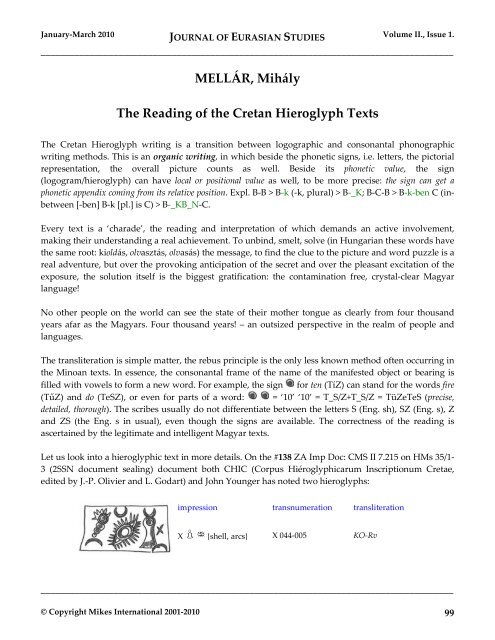EurasianStudies_0110..
EurasianStudies_0110..
EurasianStudies_0110..
You also want an ePaper? Increase the reach of your titles
YUMPU automatically turns print PDFs into web optimized ePapers that Google loves.
January-March 2010 JOURNAL OF EURASIAN STUDIES Volume II., Issue 1.<br />
_____________________________________________________________________________________<br />
MELLÁR, Mihály<br />
The Reading of the Cretan Hieroglyph Texts<br />
The Cretan Hieroglyph writing is a transition between logographic and consonantal phonographic<br />
writing methods. This is an organic writing, in which beside the phonetic signs, i.e. letters, the pictorial<br />
representation, the overall picture counts as well. Beside its phonetic value, the sign<br />
(logogram/hieroglyph) can have local or positional value as well, to be more precise: the sign can get a<br />
phonetic appendix coming from its relative position. Expl. B-B > B-k (-k, plural) > B-_K; B-C-B > B-k-ben C (inbetween<br />
[-ben] B-k [pl.] is C) > B-_KB_N-C.<br />
Every text is a ‘charade’, the reading and interpretation of which demands an active involvement,<br />
making their understanding a real achievement. To unbind, smelt, solve (in Hungarian these words have<br />
the same root: kioldás, olvasztás, olvasás) the message, to find the clue to the picture and word puzzle is a<br />
real adventure, but over the provoking anticipation of the secret and over the pleasant excitation of the<br />
exposure, the solution itself is the biggest gratification: the contamination free, crystal-clear Magyar<br />
language!<br />
No other people on the world can see the state of their mother tongue as clearly from four thousand<br />
years afar as the Magyars. Four thousand years! – an outsized perspective in the realm of people and<br />
languages.<br />
The transliteration is simple matter, the rebus principle is the only less known method often occurring in<br />
the Minoan texts. In essence, the consonantal frame of the name of the manifested object or bearing is<br />
filled with vowels to form a new word. For example, the sign for ten (TíZ) can stand for the words fire<br />
(TűZ) and do (TeSZ), or even for parts of a word: = ‘10’ ‘10’ = T_S/Z+T_S/Z = TüZeTeS (precise,<br />
detailed, thorough). The scribes usually do not differentiate between the letters S (Eng. sh), SZ (Eng. s), Z<br />
and ZS (the Eng. s in usual), even though the signs are available. The correctness of the reading is<br />
ascertained by the legitimate and intelligent Magyar texts.<br />
Let us look into a hieroglyphic text in more details. On the #138 ZA Imp Doc: CMS II 7.215 on HMs 35/1-<br />
3 (2SSN document sealing) document both CHIC (Corpus Hiéroglyphicarum Inscriptionum Cretae,<br />
edited by J.-P. Olivier and L. Godart) and John Younger has noted two hieroglyphs:<br />
impression transnumeration transliteration<br />
X {shell, arcs} X 044-005 KO-Rv<br />
_____________________________________________________________________________________<br />
© Copyright Mikes International 2001-2010 99

















